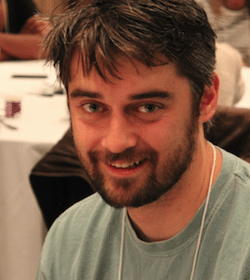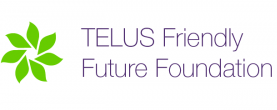This article has been reposted with the permission of the author and Thyroid Cancer Canada.
By Melissa Salvatore
 As young women, we are constantly reminded by our mothers, our doctors, and even ads posted on the stall doors in public washrooms to check our breasts for lumps, to be suspicious of moles on our bodies, and to track our menstrual cycles for irregularities. While each of these “checks” is important, what we are not often advised to do is to check our necks for lumps or enlargements that may help in the early detection of thyroid issues. This is especially important since 80 per cent of those with thyroid cancer are women, and thyroid cancer is now the number one cancer in incidence in young women. What is even more concerning is that many “healthy” young people are being told that they do not need to have an annual physical.
As young women, we are constantly reminded by our mothers, our doctors, and even ads posted on the stall doors in public washrooms to check our breasts for lumps, to be suspicious of moles on our bodies, and to track our menstrual cycles for irregularities. While each of these “checks” is important, what we are not often advised to do is to check our necks for lumps or enlargements that may help in the early detection of thyroid issues. This is especially important since 80 per cent of those with thyroid cancer are women, and thyroid cancer is now the number one cancer in incidence in young women. What is even more concerning is that many “healthy” young people are being told that they do not need to have an annual physical.
Fortunately for me, my family physician is incredibly thorough. In March 2013, he noticed something that had not been apparent during prior assessments — a significant enlargement of the left side of my neck. Within a few weeks I had an ultrasound, CT scan, and my first visit to an otolaryngologist (otherwise known as an ENT). While all of my blood work was within the normal range, the scans showed a mass of approximately 7cm x 6cm x 4cm. My first visit to the ENT resulted in a fine-needle aspiration (FNA) biopsy, which confirmed that I had papillary thyroid carcinoma that had metastasized into the lymph nodes in my neck.
The “good” cancer
Most information about thyroid cancer will tell you it is a “good” cancer, that the prognosis for survival is very high. It is a disease that is slow-growing and rarely extends beyond the thyroid. In cases where it does, it is generally confined to the nearby lymph nodes in the neck. While these stats are reassuring, I don’t think that anything can truly minimize the impact of hearing “You have CANCER” at the age of 29.
Just eight weeks after the initial discovery of this mass, I was lying on the operating room table at the Ottawa General Hospital, preparing to have a total thyroidectomy and a lateral neck dissection to remove the affected lymph nodes. I was terrified. Would I be able to talk again? What would they find once they opened me up? How would this impact the rest of my life? Was I going to live? I knew that I would have a scar that would extend from just right-of-centre of my neck, all the way across and up behind my left ear. I would also be required to take a tiny pill each day for the rest of my life to provide my body with the essential hormones typically produced by the thyroid.
Fortunately, my surgery was a success, and I did not experience any significant discomfort. In total, the doctors removed 40 lymph nodes on the left side of my neck, in addition to other soft tissues and the full thyroid. The pathology report showed that both sides of my thyroid contained malignant tumors, and that 22 of the 40 lymph nodes removed from my neck were also cancerous. Due to the extensive spread of the disease, additional treatment was required, and I was scheduled for a radioactive iodine treatment (RAI).
While most people were enjoying summer BBQs in July, I was preparing to drink a dose of RAI that would result in a period of isolation to protect those around me while my body processed the toxic cocktail needed to kill any tissues not removed during surgery. I prepared for the RAI treatment with Thyrogen injections that I received each of the two days prior to the RAI dose. Other than the unsettling feeling of drinking a toxic substance, my RAI treatment went well. The period of strict isolation was long, but I filled the time and anxiously awaited my upcoming whole body scan (WBS).
After the iodine
While I do not think that anything can ever adequately prepare you for the news that “You have cancer,” the ultimate shock for me came in hearing the news that the cancerous thyroid tissues had moved through my upper chest and into both of my lungs. Since I had had my entire thyroid removed and the RAI treatment to kill any remaining tissues, my blood work ideally should have shown no presence of Thyroglobulin (a thyroid cancer marker test). Unfortunately, not only did the scan show a significant spread of thyroid tissues in my body, but also my Thyrogobulin levels were quite high, confirming the extensive spread of the disease.
While my positive and determined attitude did not change with this latest news, I was now shaken to my core. I became terrified of all of the “what ifs.” To make matters worse, my body needed a chance to process the recent dose of RAI, meaning that I would have to wait at least four months before beginning any other form of treatment. It was at this point that I realized the “good” cancer could sometimes misbehave.
My doctors could not say with certainty what my prognosis was, or what long-term effects this disease might have on my body. While it is typically slow growing, allowing patients to live long lives, I was told that I would likely have to get used to the idea of “living with” thyroid cancer, since once it has spread into the lungs, it is generally not curable. I searched endlessly for answers as to what the next steps would be if the upcoming round of treatment was ineffective, or what implications this would have on being able to one day start a family.
I began having regular acupuncture treatments by a doctor of Traditional Chinese Medicine, I took part in a nutrition program at the Maplesoft Centre (a cancer survivorship centre), and I joined the Ottawa Integrative Cancer Centre (OICC), where I began seeing a Naturopathic Oncologist and a Nutritionist. These practitioners, along with other alternative medical practitioners whose expertise I had relied on long before my diagnosis (Naturopath, Chiropractor and Registered Massage Therapists), helped me to believe that while we may not be able to cure cancer, we can most definitely support our bodies to fight the disease and to minimize the negative impacts the various forms of treatment may have.
Time did eventually pass, and I was scheduled for a CT scan of my head, neck and chest. The scan results gave hope, as the tissues that showed up after my treatment on the WBS were not visible on the CT scan, indicating that they were too small to be detected.
I was scheduled for my second dose of RAI, however, this time, I would not use the convenient Thyrogen injections to prepare. Rather, I would be removed entirely from my thyroid hormones to achieve a state of severe hypothyroidism. Throughout this period, I once again adhered to a low iodine diet. Despite my body’s weakened state, my treatment went well. Due to the fatigue, the time in isolation passed quickly.
Fortunately, as the doctors hoped, this treatment was effective! In fact, it was more effective than they had thought would be possible in the short-term, with the follow up scan showing that 99 per cent of the cancerous tissues that had been present just a few months earlier were no longer visible. The remaining tissue was currently radioactive avid, indicating that it had absorbed the treatment. These positive results were further affirmed by my blood work that showed my Thyroglobulin level had dropped from 337 to 0.5 pmol/L and within a few months was considered undetectable.
A deepened level of self-awareness, my enhanced perspective on life, and better appreciation for what is really important are just some of the valuable lessons I have learned. While most of the lessons learned will impact my life in a positive manner, I know that I have lost a sense of naivete that I will likely never get back. Fortunately, I am surrounded with a competent and compassionate medical team that gives me confidence in its ability to support my long-term health and well-being.
Despite some of the enduring worries, I will be forever grateful for the good that has come from this experience, and I know that I am a better and stronger person. The peace of knowing that some of my most valuable relationships were strengthened rather than weakened through this process is incredible. I am confident that this will allow me to be a better wife, daughter, sister, friend, colleague, professional, and I hope in the not-too-distant future, a better mother. One thing for sure is that I will no longer limit my list of “checks” to breasts, moles and menstrual cycles, but will share broadly the importance of performing a neck check. While thyroid cancer may be better than most, no cancer is a “good” cancer, and if we can all do our part to share, perhaps thyroid issues can be identified at the earliest possible stage.
Melissa is a member of Thyroid Cancer Canada and lives in Ottawa with her husband David. She works as a Human Resources Professional.









